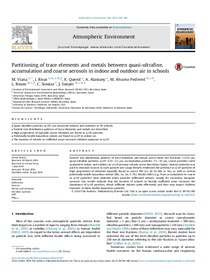Welcome to the UPF Digital Repository
Partitioning of trace elements and metals between quasi-ultrafine, accumulation and coarse aerosols in indoor and outdoor air in schools
JavaScript is disabled for your browser. Some features of this site may not work without it.
| dc.contributor.author | Viana, Maria Carmen |
| dc.contributor.author | Rivas, Ioar |
| dc.contributor.author | Querol, Xavier |
| dc.contributor.author | Alastuey, Andrés |
| dc.contributor.author | Álvarez Pedrerol, Mar |
| dc.contributor.author | Bouso, Laura |
| dc.contributor.author | Sioutas, Constantinos |
| dc.contributor.author | Sunyer Deu, Jordi |
| dc.date.accessioned | 2016-04-18T14:55:35Z |
| dc.date.available | 2016-04-18T14:55:35Z |
| dc.date.issued | 2015 |
| dc.identifier.citation | Viana M, Rivas I, Querol X, Alastuey A, Alvarez-Pedrerol M, Bouso L et al. Partitioning of trace elements and metals between quasi-ultrafine, accumulation and coarse aerosols in indoor and outdoor air in schools. Atmospheric environment. 2015;106:392-401. DOI: 10.1016/j.atmosenv.2014.07.027 |
| dc.identifier.issn | 1352-2310 |
| dc.identifier.uri | http://hdl.handle.net/10230/26115 |
| dc.description.abstract | Particle size distribution patterns of trace elements and metals across three size fractions (<0.25 μm, quasi-ultrafine particles, q-UF; 0.25–2.5 μm, accumulation particles; 2.5–10 μm, coarse particles) were analysed in indoor and outdoor air at 39 primary schools across Barcelona (Spain). Special attention was paid to emission sources in each particle size range. Results evidenced the presence in q-UF particles of high proportions of elements typically found in coarse PM (Ca, Al, Fe, Mn or Na), as well as several potentially health-hazardous metals (Mn, Cu, Sn, V, Pb). Modal shifts (e.g., from accumulation to coarse or q-UF particles) were detected when particles infiltrated indoors, mainly for secondary inorganic aerosols. Our results indicate that the location of schools in heavily trafficked areas increases the abundance of q-UF particles, which infiltrate indoors quite effectively, and thus may impact children exposure to these health-hazardous particles. |
| dc.description.sponsorship | The research leading to these results has received funding from the European Research Council under the ERC Grant Agreement number 268479 – the BREATHE project. Additional funding for specific instrumentation was provided by national project IMPACT (CGL 2011-26574), the Spanish Ministry of Agriculture, Food and the Environment (UCA 2009020083), and projects VAMOS (CLG 2010-19464-CLI) and GRACCIE CSD2007-00067. Support is acknowledged to Generalitat de Catalunya 2009 SGR8. |
| dc.format.mimetype | application/pdf |
| dc.language.iso | eng |
| dc.publisher | Elsevier |
| dc.relation.ispartof | Atmospheric environment. 2015;106:392-401 |
| dc.rights | © 2014 The Authors. Published by Elsevier Ltd. This is an open access article under the CC BY-NC-ND license (http://creativecommons.org/licenses/by-nc-nd/3.0) |
| dc.rights.uri | http://creativecommons.org/licenses/by-nc-nd/3.0 |
| dc.subject.other | Aire -- Contaminació |
| dc.subject.other | Infants -- Desenvolupament |
| dc.title | Partitioning of trace elements and metals between quasi-ultrafine, accumulation and coarse aerosols in indoor and outdoor air in schools |
| dc.type | info:eu-repo/semantics/article |
| dc.identifier.doi | http://dx.doi.org/10.1016/j.atmosenv.2014.07.027 |
| dc.subject.keyword | Infiltration |
| dc.subject.keyword | Sources |
| dc.subject.keyword | Metals and elements |
| dc.subject.keyword | Ultrafine particles |
| dc.subject.keyword | UFP |
| dc.subject.keyword | PM0.25 |
| dc.relation.projectID | info:eu-repo/grantAgreement/EC/FP7/268479 |
| dc.rights.accessRights | info:eu-repo/semantics/openAccess |
| dc.type.version | info:eu-repo/semantics/publishedVersion |


